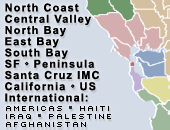South Coast Marine Protected Areas are Habitat for Humanity, Not Habitat Over Humanity
The last few weeks have epitomized the historic process and passionate public participation integral to the creation of marine protected areas off California’s Coast. The Blue Ribbon Task Force of experts spent three days between October 20-22th intensely deliberating the options for a network of protected areas off the South Coast, between Point Conception and the California/Mexico Border. The issue inspired passionate participation from many different groups, including some industry interests who used underhanded tactics and junk science to try to stop the creation of marine protected areas altogether. When the Task Force was unable to resolve all issues in the October meeting, they reconvened on November 10th for yet another round of deliberation, public comment, and careful review.
At the October and November meetings combined, over 1,500 public comment cards were submitted and hundreds of people waited many hours to offer their perspective as public comment. The Task Force also received tens of thousands of letters and emails representing every perspective on this important public decision.
The experts had a Herculean task before them and did a commendable job of reviewing the science evaluations and synthesizing constructive public comment. At the end of a very long day, the Task Force unanimously voted on a preferred alternative that pulled together elements of the different stakeholder options. Although Conservationists were disappointed with important missed opportunities for ecosystem restoration, the preferred alternative contained something for everyone. As Garth Murphy, a member of the South Coast regional stakeholder group commented, the preferred network achieved habitat for humanity, rather than habitat over humanity. Click here for maps of the options the Task Force considered. At the four most hotly contested areas along the South Coast, the Task Force adopted:
Option 1 at Point Dume, slightly moving the western border of the marine reserve to a river mouth.
Option 2 at Palos Verdes. This leaves Rocky Point, a coveted fishing spot, completely open, and creates a significant gap in persistent kelp and shallow rocky reef (which is critical nursery habitat), right in the middle of the network. This gap is a major problem because Rocky Point – called the “jewel” of the network because it has the highest larval production, according to bioeconomic models – would have increased the effectiveness of the MPA network, even if only partially protected.
Option 2 in Orange County, with a small boundary adjustment to increase the feasibility of compliance and enforcement.
Option 2 in San Diego was chosen to minimize potential impacts on and address concerns of fishermen. The protected areas at La Jolla are below minimum size, but still include high quality kelp and reef habitats (Option 1 would have met science guidelines with a minimum size MPA at La Jolla). The protected area at Swami’s also includes diverse habitat.
Although the chosen preferred alternative will certainly be better than the current skeleton of protection now in place – the Task Force made some compromises, especially at Palos Verdes, that run contrary to the science and will increase the risk that the network will fail to achieve the essential purposes of the Marine Life Protection Act.
We appreciate the experts’ effort to strike a compromise, but it is important to know that the preferred alternative adopted by the Task Force offers significantly less protection than the networks that have been adopted in the Central Coast and the North Central Coast. As Kaitilin Gaffney of the Ocean Conservancy stated in her public comment, this alternative is “pretty close to the bone” with minimum size reserves (protecting a smaller range of species than preferred size) and maximum spacing (creating a gap in larval exchange).
Karen Garrison of NRDC encouraged the Task Force to keep in mind the enormous pressure that we put on our coasts and the value of ensuring healthy ecosystems for generations yet unborn to enjoy. Fortunately, the preferred alternative includes iconic places like Naples Reef, Point Dume Canyon and La Jolla South. It also protects some high quality kelp, rocky reef pinnacle and canyon habitats.
Get Involved
If you'd like to help with maintaining or developing the website, contact us.
Publish
Publish your stories and upcoming events on Indybay.



